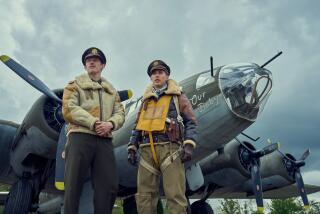In Plane Sight at March Field
- Share via
RIVERSIDE — No one in my family has been in the military since the Civil War, and I’ve never been curious about planes. So when my husband, Ralph, suggested we visit March Field Air Museum, my first response was a lengthy yawn. Then I had an idea: “OK, if we can spend a night at the Mission Inn.” I had heard so much about this historic hotel that I thought it might be fun to stay there and form my own opinion.
So what started as a compromise ended up as an enjoyable getaway last month. By the time we left March Field, I was eager to learn more about the planes that have helped shape U.S. history.
For the record:
12:00 a.m. Dec. 27, 2000 For the Record
Los Angeles Times Wednesday December 27, 2000 Home Edition Part A Part A Page 3 Metro Desk 1 inches; 27 words Type of Material: Correction
Weekend Escape--In Sunday’s Travel section, the Weekend Escape story on the March Field Air Museum misidentified a plane in a photo caption. The aircraft pictured on the right was an F-101.
For the Record
Los Angeles Times Sunday December 31, 2000 Home Edition Travel Part L Page 5 Travel Desk 1 inches; 32 words Type of Material: Correction
Weekend Escape--In the Dec. 24 Travel section, a Weekend Escape story on the March Field Air Museum (“In Plane Sight at March Field”) misidentified a plane in a photo caption. The aircraft on the right was an F-101, not an F-102.
Riverside is about 60 miles east of Los Angeles and, from our home in Upland, only a 35-minute drive in Friday afternoon traffic. We crossed the Santa Ana River channel and arrived at the Mission Inn, in the heart of downtown.
Entering the hotel was like finally meeting a celebrity you’ve heard too much about: I was fully prepared not to like it. But the friendly staff and the eclectic architectural styles--Mission Revival with Gothic, Tudor, Baroque, Italian Renaissance and other influences--won me over.
Built piecemeal from 1903 to 1931, the Mission Inn was reopened in 1993 after a $55-million renovation. (About 80% of the 235 guest rooms were renovated again last year, according to marketing director Ellen Smith.)
I found a surprise around every corner: a fountain here, a stained-glass window there, plus paintings, statues, turrets, niches and great rooftop views. Workers were decorating for Christmas, and all manner of elves, choristers and snowmen were lying around waiting to be installed and plugged in. Our deluxe room was spacious and serene in shades of brown, with a balcony overlooking the garden and pool.
We could have eaten at the Mission Inn Restaurant, but a hotel clerk had recommended Duane’s, the more elegant of the hotel’s two restaurants, describing it as “amazing.” When we went down for dinner, we found the room elegant indeed, with white linens, gleaming silverware and oil paintings spotlighted on the walls.
We split a Caesar salad, prepared table-side, and we both ordered steaks of prime Angus beef. They were grilled perfectly, medium rare as ordered, and were complemented with a nice bottle of Beaulieu Vineyard Carneros Pinot Noir. Ralph liked his crispy fries, but my garlic mashed potatoes were overly whipped and too salty.
A smiling, white-jacketed server poured water from bottles chilled in wine buckets, so nothing as crude as an ice cube clunked in the goblet. The dinner was good, if not amazing.
Saturday morning, we hopped on Interstate 215 for a 10-minute ride south. At the Van Buren exit, we saw the distinctive orange and white checkerboard roof of March Field Air Museum, which is open 10 a.m. to 4 p.m. daily.
Because it was Veterans Day, aircraft that normally are viewed only on the outside were opened so visitors could peek at the cockpits and cargo holds. Lots of volunteers, many of them veterans, were on hand to answer questions. (Similar “open aircraft” viewings are held four times a year; the next is in April.)
The first plane we saw looked familiar. Did you see Tommy Lee Jones kiss Marcia Gay Harden under a big black spy plane in “Space Cowboys”? That was the SR-71, or the Blackbird. But the titanium-clad aircraft was a headliner long before the scene hit theaters. In 1976 a plane like this one flew higher (above 85,000 feet) and faster (2,193 mph) than any other; to this day, no plane has beat the SR-71’s mark.
Ralph was impressed by the Blackbird’s appearance and capabilities. Its surveillance cameras could read a logo on a baseball cap from 80,000 feet. As remarkable as that is, the cockpit looks old-fashioned with its analog instruments, built in the pre-digital mid-’60s. Alas, the Blackbird has been retired (some admirers say prematurely), replaced by cheaper unmanned satellites.
As we strolled around in the sun, a plane periodically took off from the March Air Reserve Base runway next door. When the roar receded, I heard recorded World War II-era music emanating from speakers: “Don’t Sit Under the Apple Tree” and “Lili Marlene.”
With more than 50 planes on display, I was overwhelmed and confused by their names. What do those letters mean, anyway? C this, T that, F-14, B-47 . . .
Ralph looked as if I were kidding and said, “You don’t even know B stands for bomber?” Replacing sarcasm with pity, he explained patiently that C stands for cargo, F for fighter and T for trainer; KC signifies an aircraft that refuels other planes, the K derived from the word tanker.
A world opened up. What I thought was arbitrary now made sense. I began reading the signs with more interest, wondering what human stories had played out in each plane.
Leaving Ralph studying the swept-wing design of the B-47, I walked over to the huge B-52. Dick Heitman, a volunteer from Banning, said he commanded a B-52 during the Vietnam War. On the night of Dec. 18, 1972, he recalled, he and five other crew members based in Guam dropped a full payload--108 bombs weighing 500 pounds each--near Hanoi. Peace accords were signed a month later.
Over at the KC-135, I climbed a metal stairway to look inside. Troop seats lined both sides of the fuselage, with an open space for cargo in the middle. In the tail, I crouched down to see a padded “ironing board” where a crew member would lie facing out the back to guide the refueling boom into position.
Next I went to the restoration hangar, where three new acquisitions were in various stages of repair and painting. One of them was an OH-6 helicopter that served in Vietnam. Shayne Meder, an Air Force veteran and restoration manager for the museum, researched its serial number and found that it had been shot down four times in 1970 and 1971.
“Everyone has a different reaction to the planes,” said Meder, who often chats with visitors. “Kids look at them and say, ‘Oh, wow!’ Young people in their teens and 20s haven’t really been exposed to war, so they learn about history. And I get to hear the stories of Korean vets and Vietnam vets and the World War II vets, but there aren’t as many of them as there used to be.”
Ralph and I met up inside the main hangar, where visitors learn about the history of March Field since its opening in 1918. Small and colorful planes from the 1930s and ‘40s were on display, looking like toys compared with the ones outside. We saw engines, wooden propellers and training simulators, as well as photos and memorabilia from both World Wars, the Cold War, Vietnam and Desert Storm.
Back at the hotel, we checked out, stowed our bags in the car and walked across Main Street to Simple Simon’s for lunch. Tables were set up outside in the pedestrian mall, but the chill urged us inside. High-backed booths, red brick walls and a steady stream of customers gave it a cozy, neighborly atmosphere.
Ralph’s black bean chili was topped with cheese, avocado, tomato, sour cream and onion, with cornbread on the side. I polished off a huge hot croissant filled with ham and cheese.
On the ride home, my thoughts returned to the variety of aircraft I had seen that morning, surprised at how much they had fascinated and educated me. Even though they no longer take to the skies, they serve a worthy purpose on the ground.
(BEGIN TEXT OF INFOBOX / INFOGRAPHIC)
Budget for Two
Mission Inn, one night: $165.39
Admission, air museum: 10.00
Dinner, Duane’s: 139.06
Lunch, Simple Simon’s: 18.05
Gas: 8.00
FINAL TAB: $340.50
Mission Inn, 3649 Mission Inn Ave., Riverside, CA 92501; telephone (909) 784-0300, fax (909) 683-1342, Internet https://www.missioninn.com. March Field Air Museum, P.O. Box 6463, March Air Reserve Base, CA 92518; tel. (909) 697-6600, fax (909) 697-6605, Internet https://www.marchfield.org.
More to Read
Sign up for The Wild
We’ll help you find the best places to hike, bike and run, as well as the perfect silent spots for meditation and yoga.
You may occasionally receive promotional content from the Los Angeles Times.






